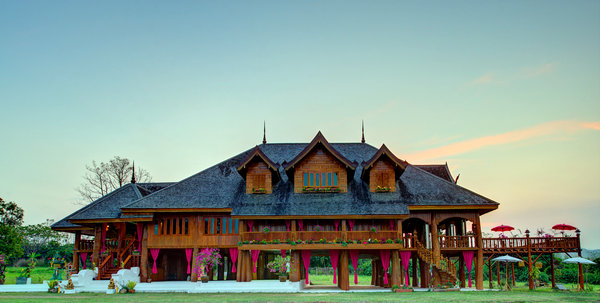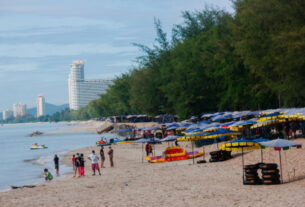When the Nathanson family first saw this house near Chiang Mai, Thailand, it was practically derelict. Thieves had stripped the unfinished structure and it was overgrown with vegetation.
 There are centuries of stories contained in the meter-thick teak columns of Barry Nathanson’s luxury fixer-upper in the northern hills of Thailand.
There are centuries of stories contained in the meter-thick teak columns of Barry Nathanson’s luxury fixer-upper in the northern hills of Thailand.
The columns — 50 of them, each 9 meters, or 30 feet, tall — are the structural support for the house, built with scholarly precision in the Lanna Thai style.
Lanna kings ruled much of the region beginning in the 13th century, and the wealthy and powerful of the empire built their mansions with wood from the abundant forests between the modern-day city of Chiang Mai and what is now the border with Myanmar.
Most prized was golden teak, which is what covers the exterior of Mr. Nathanson’s 1,580-square-meter, or 17,000-square-foot, house — not the golden teak farmed today in China for high-end flooring but the far denser, richer and more lustrous original variety that Thai legend says actually contains gold dust.
Mr. Nathanson, 46, the self-avowed “black sheep” of a New York family of attorneys and brokers, is happy to pass on such details from the encyclopedic knowledge of Lanna history he acquired during five years of restoration work on the house, which he has put on the market for $1 million.
A 40-minute drive from Chiang Mai International Airport in the rapidly developing district of Maetaeng, the house was an abandoned ruin when Mr. Nathanson and his wife, Sukanya, who is Thai, came across it by accident during a trip from their island home in Phuket.
Construction was started in 2005 by what Mr. Nathanson refers to as “a very rich and very powerful local family,” but stopped abruptly in 2006 after then-Prime Minister Thaksin Shinawatra, one of the region’s best-known native sons, was deposed in a military coup.
When the Nathansons first saw the house, it was so overgrown that the only thing visible from the road was the characteristic chofa, a kind of feather-shaped finial adorning the peak of the roof. Virtually all the exterior teak had been stripped off and carted away by thieves.
Nonetheless, it was love at first sight, say the Nathansons, who have built or restored several properties in Thailand, including a temple-style, multi-building compound on the beach in Phuket.
They purchased the Maetaeng house at a bank auction, outbidding a relative of the original owner who had made a low offer because, as Mr. Nathanson said, “I don’t think they expected that anybody would be crazy enough to take this on, especially a ‘farang,”’ the Thai word for Westerner.
The restoration has been undertaken with obsessive attention to traditional style, including consultations with Ajarn Chulathat Kitibutr, an architect and Lanna scholar who designed the Four Seasons resort in nearby Maerim. A 15-member crew worked full time during the height of the project, employing traditional Lanna tools and tongue-and-groove construction, using no nails.
The couple’s energetic son, six-year-old David, is so fluent in Thai from his studies at the village school a five-minute drive away that he has been translating his father’s instructions to workers.
Characteristically, the house’s ground floor is a little more than 3.5 meters off the ground, as protection from flooding, which is rare in this area, and from wild animals, mostly feral cats and dogs.
Up a flight of teak stairs, the main floor is a vast expanse of gleaming wood surrounded by windows — 140 in all in the house — that open onto a 50-meter-long deck on the north side, with terraces to the south and east.
A spiral staircase leads to three large bedrooms, each 48 square meters, with en suite tiled bathrooms, one of which has a teak tub.
When work began, “I still had money, so we got a lot accomplished in the first three years,” said Mr. Nathanson, who once owned a successful textile factory in California.
The pace was somewhat determined by the availability of golden teak, the sale of which is controlled by the Thai government. The government itself occasionally cuts some of the trees in the course of road construction and public-works projects, and the national forestry ministry sells the wood in a very competitive market.
As scarce as golden teak is, whole trees nine meters in length, which Mr. Nathanson needed for the support columns, are rarer still. “We often had to wait months for wood,” he said. “Once we found it, there was the problem of getting these huge pieces here without breaking them up. More than once, we had trucks collapse on their tires from the weight.”
Salvaged teak for exterior walls was only somewhat easier to acquire, requiring scouting missions around northern Thailand — and a pocketful of ready cash. “You have to be ready to act fast,” Mr. Nathanson said.
The provenance of every piece of teak has been documented. The Nathansons’ ledger itemizes hundreds of golden teak panels, 65 antique Burmese teak balusters, 163,000 hand-cut teak roof shingles — all with prices and dates of purchase. Factoring in the cost of mai daeng, a dense Thai redwood, for floors and interior walls and less-expensive teng wood for framing the bedrooms, slightly more than $1 million was invested in materials alone, Mr. Nathanson estimated.
Last spring, with a seasonal haze obscuring the 360-degree view of the Lanna hills, Mr. Nathanson put the house on the market, a tentative effort involving a Web page. He says he has had 15 inquiries, including several individuals interested in transforming the 25-rai, or roughly 10-acre, property, into a resort, but no real offers.
Last month, he was awaiting a final shipment of teak and redwood. So by July, exactly on schedule according to his five-year plan, the only work left to finish will be landscaping and completing the swimming pool that was dug during flusher times.
“Basically, I’m broke-broke,” he said. Most of his income comes from three rental apartments in the Coney Island neighborhood of New York, one of which has been on the market for more than a year. He has enough to live comfortably — with a housekeeper, cook and masseur on call — but eking out the finishing details on the house could take years, he figures.
“In all my businesses, I have always been able to raise whatever money I needed. But the people I could always rely on are all hurting in the U.S. economy,” he said. After nine years in Thailand, where the unofficial national motto is “mai pen rai,” or “it’s not important,” he says he is “not as hungry as I used to be.”
“If somebody comes along with a million dollars and enough money to really do this place up the way it deserves, I would have a hard time saying no,” he continued. “On the other hand, where I am now, who’s complaining?”



